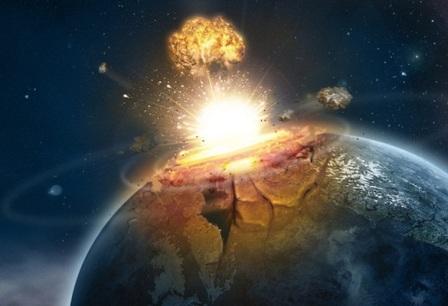The 55 foot wide rock, said by Nasa to have a mass of 10,000 tonnes, lit up the sky above the Urals region on Friday morning, causing shockwaves that injured 1,200 people and damaged thousands of homes in an event unprecedented in modern times.
Nasa estimated that the energy released as the meteor’s disintigrated in the atmosphere was 500 kilotons, around 30 times the size of the nuclear bomb dropped on Hiroshima in 1945.
It entered the atmosphere at 44,000 miles per hour, taking 32.5 seconds to break up at an altitude of around 15 miles above the earth’s surface.
The resulting explosion created a shockwave that blew out windows and set of car alarms in Chelyabinsk two and a half minutes later.
Divers were this morning searching the Chelyabinsk region’s frozen Lake Chebarkul for a fragment of the meteorite.
No fragments have been found in the region so far – despite some 20,000 rescuers and recovery workers being dispatched to help the hundreds of people injured.
An army of glaziers were also being transported to Chelyabinsk to repair the thousands of broken windows in homes in the city, where night time temperatures fall below -15C.
Scientists from Nasa, the US space agency, estimated that the amount of energy released from impact with the atmosphere was about 30 times greater than the nuclear bomb dropped on the Japanese city of Hiroshima during World War II.
“We would expect an event of this magnitude to occur once every 100 years on average,” said Paul Chodas of Nasa’s Near-Earth Object Program Office.
“When you have a fireball of this size we would expect a large number of meteorites to reach the surface and in this case there were probably some large ones,” he said in a statement published on the Nasa website.
The strike brought traffic to a halt in the industrial city of Chelyabinsk as residents poured out on the streets to watch the light show before hovering for safety as a sonic boom shattered glass and set off car alarms. Most of the injuries were caused by glass.
“We have a special team working… that is now assessing the seismic stability of buildings,” Vladimir Puchkov, the Emergencies Minister, told residents as he inspected the damage in the city.
“We will be especially careful about switching the gas back on,” he said in televised remarks.
The meteor explosion appears to be one of the most stunning cosmic events above Russia since the 1908 Tunguska Event in which a massive blast most scientists blame on an asteroid or a comet ripped through Siberia.
Russian scientists were initially reported to have estimated its mass to be around 10 tonnes, but Nasa later claimed it was considerably larger with a mass closer to 10,000 tonnes.
The drama in Russia developed just hours before an asteroid – a space object similar to a tiny planet orbiting the sun – whizzed safely past Earth at the unprecedented distance of 17,200 miles.
That put it closer to the ground then some distant satellites and sent off alarm bells ringing in some Russian circles about this being the time for joint global action on the space safety front.
“Instead of fighting on Earth, people should be creating a joint system of asteroid defence,” the Russian parliament’s foreign affairs committee chief Alexei Pushkov wrote on his Twitter account late Friday.
“Instead of creating a (military) European space defence system, the United States should join us and China in creating the AADS – the Anti-Asteroid Defence System,” the close ally of President Vladimir Putin wrote.
The US space agency said the 2012 DA 14 asteroid’s passing was “the closest-ever predicted approach to Earth for an object this large.”
Nasa estimated that a smallish asteroid such as the 2012 DA 14 flies close to Earth every 40 years on average while only hitting the planet once every 1,200 years.
Astronomers have detected some 9,500 celestial bodies of various sizes that pass near Earth.

